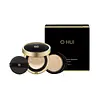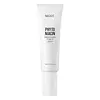What's inside
What's inside
 Key Ingredients
Key Ingredients

 Benefits
Benefits

 Concerns
Concerns

 Ingredients Side-by-side
Ingredients Side-by-side

Water
Skin ConditioningTriethylhexanoin
MaskingTitanium Dioxide
Cosmetic ColorantDimethicone
EmollientPhenyl Trimethicone
Skin ConditioningButylene Glycol Dicaprylate/Dicaprate
EmollientCyclopentasiloxane
EmollientDipentaerythrityl Hexa C5-9 Acid Esters
Skin ConditioningCetyl PEG/PPG-10/1 Dimethicone
EmulsifyingPhenylbenzimidazole Sulfonic Acid
UV AbsorberNiacinamide
Smoothing1,2-Hexanediol
Skin ConditioningTromethamine
BufferingLilium Tigrinum Extract
Skin ConditioningSorbitan Sesquioleate
EmulsifyingDisteardimonium Hectorite
StabilisingDimethicone/Vinyl Dimethicone Crosspolymer
Skin ConditioningSodium Chloride
MaskingMyristica Fragrans Extract
MaskingLuffa Cylindrica Fruit Extract
Skin ConditioningZinc Stearate
Cosmetic ColorantPanthenol
Skin ConditioningPEG-30 Dipolyhydroxystearate
EmulsifyingDimethicone/Polyglycerin-3 Crosspolymer
CleansingAluminum Hydroxide
EmollientStearic Acid
CleansingDistearyldimonium Chloride
Stearyl Glycyrrhetinate
Skin ConditioningDimethicone/PEG-10/15 Crosspolymer
Acrylates/Stearyl Acrylate/Dimethicone Methacrylate Copolymer
Palmitoyl Proline
Skin ConditioningTriethoxysilylethyl Polydimethylsiloxyethyl Hexyl Dimethicone
Skin ConditioningAdenosine
Skin ConditioningTriethoxycaprylylsilane
Biosaccharide Gum-1
HumectantMagnesium Palmitoyl Glutamate
Skin ConditioningSodium Palmitoyl Sarcosinate
CleansingDipropylene Glycol
HumectantPropylene Carbonate
SolventAlumina
AbrasiveSodium Citrate
BufferingEthylhexylglycerin
Skin ConditioningSilica
AbrasiveTocopherol
AntioxidantPolymethylsilsesquioxane
Parfum
MaskingHydroxycitronellal
PerfumingLimonene
PerfumingMica
Cosmetic ColorantCI 77492
Cosmetic ColorantCI 77491
Cosmetic ColorantCI 77499
Cosmetic ColorantWater, Triethylhexanoin, Titanium Dioxide, Dimethicone, Phenyl Trimethicone, Butylene Glycol Dicaprylate/Dicaprate, Cyclopentasiloxane, Dipentaerythrityl Hexa C5-9 Acid Esters, Cetyl PEG/PPG-10/1 Dimethicone, Phenylbenzimidazole Sulfonic Acid, Niacinamide, 1,2-Hexanediol, Tromethamine, Lilium Tigrinum Extract, Sorbitan Sesquioleate, Disteardimonium Hectorite, Dimethicone/Vinyl Dimethicone Crosspolymer, Sodium Chloride, Myristica Fragrans Extract, Luffa Cylindrica Fruit Extract, Zinc Stearate, Panthenol, PEG-30 Dipolyhydroxystearate, Dimethicone/Polyglycerin-3 Crosspolymer, Aluminum Hydroxide, Stearic Acid, Distearyldimonium Chloride, Stearyl Glycyrrhetinate, Dimethicone/PEG-10/15 Crosspolymer, Acrylates/Stearyl Acrylate/Dimethicone Methacrylate Copolymer, Palmitoyl Proline, Triethoxysilylethyl Polydimethylsiloxyethyl Hexyl Dimethicone, Adenosine, Triethoxycaprylylsilane, Biosaccharide Gum-1, Magnesium Palmitoyl Glutamate, Sodium Palmitoyl Sarcosinate, Dipropylene Glycol, Propylene Carbonate, Alumina, Sodium Citrate, Ethylhexylglycerin, Silica, Tocopherol, Polymethylsilsesquioxane, Parfum, Hydroxycitronellal, Limonene, Mica, CI 77492, CI 77491, CI 77499
Water
Skin ConditioningButylene Glycol
HumectantGlycerin
HumectantDimethicone
EmollientCyclopentasiloxane
EmollientTitanium Dioxide
Cosmetic ColorantNiacinamide
SmoothingPanthenol
Skin ConditioningSodium Polyacrylate
AbsorbentEthylhexyl Stearate
EmollientSodium Acrylate/Sodium Acryloyldimethyl Taurate Copolymer
Emulsion StabilisingIsohexadecane
EmollientDimethiconol
EmollientTrideceth-6
EmulsifyingTriethoxycaprylylsilane
Aluminum Hydroxide
EmollientAdenosine
Skin ConditioningPolysorbate 80
EmulsifyingDisodium EDTA
Sorbitan Oleate
EmulsifyingCamellia Japonica Seed Oil
EmollientCeramide NP
Skin ConditioningAllantoin
Skin ConditioningCitrus Paradisi Fruit Extract
Skin ConditioningBambusa Vulgaris Extract
Skin ConditioningCentella Asiatica Extract
CleansingPentylene Glycol
Skin Conditioning1,2-Hexanediol
Skin ConditioningAnthemis Nobilis Flower Extract
MaskingCaprylyl Glycol
EmollientMadecassoside
AntioxidantBeta-Glucan
Skin ConditioningPalmitoyl Tripeptide-5
Skin ConditioningCopper Tripeptide-1
Skin ConditioningWater, Butylene Glycol, Glycerin, Dimethicone, Cyclopentasiloxane, Titanium Dioxide, Niacinamide, Panthenol, Sodium Polyacrylate, Ethylhexyl Stearate, Sodium Acrylate/Sodium Acryloyldimethyl Taurate Copolymer, Isohexadecane, Dimethiconol, Trideceth-6, Triethoxycaprylylsilane, Aluminum Hydroxide, Adenosine, Polysorbate 80, Disodium EDTA, Sorbitan Oleate, Camellia Japonica Seed Oil, Ceramide NP, Allantoin, Citrus Paradisi Fruit Extract, Bambusa Vulgaris Extract, Centella Asiatica Extract, Pentylene Glycol, 1,2-Hexanediol, Anthemis Nobilis Flower Extract, Caprylyl Glycol, Madecassoside, Beta-Glucan, Palmitoyl Tripeptide-5, Copper Tripeptide-1
Ingredients Explained
These ingredients are found in both products.
Ingredients higher up in an ingredient list are typically present in a larger amount.
1,2-Hexanediol is a synthetic liquid and another multi-functional powerhouse.
It is a:
- Humectant, drawing moisture into the skin
- Emollient, helping to soften skin
- Solvent, dispersing and stabilizing formulas
- Preservative booster, enhancing the antimicrobial activity of other preservatives
Adenosine is in every living organism. It is one of four components in nucleic acids that helps store our DNA.
Adenosine has many benefits when used. These benefits include hydrating the skin, smoothing skin, and reducing wrinkles. Once applied, adenosine increases collagen production. It also helps with improving firmness and tissue repair.
Studies have found adenosine may also help with wound healing.
In skincare products, Adenosine is usually derived from yeast.
Learn more about AdenosineAluminum Hydroxide is a form of aluminum. It can be naturally found in nature as the mineral gibbsite. In cosmetics, Aluminum Hydroxide is used as a colorant, pH adjuster, and absorbent.
As a colorant, Aluminum Hydroxide may add opacity, or reduce the transparency. Aluminum hydroxide is contains both basic and acidic properties.
According to manufacturers, this ingredient is an emollient and humectant. This means it helps hydrate the skin.
In medicine, this ingredient is used to help relieve heartburn and help heal ulcers.
There is currently no credible scientific evidence linking aluminum hydroxide in cosmetics to increased cancer risk.
Major health organizations allow the use of aluminum hydroxide in personal care products and have not flagged it as a carcinogenic risk at typical usage levels.
Learn more about Aluminum HydroxideCyclopentasiloxane, or D5, is a silicone used to improve texture of products and trap moisture.
D5 is considered lightweight and volatile. Volatile means it evaporates quickly after application. Once evaporated, D5 leaves a thin barrier that helps keep skin hydrated.
It is also an emollient. Emollients help soften the skin and prevent water loss. Silicones create a silky texture in products. D5 helps other ingredients become more spreadable.
Studies show D5 is safe to use in skincare products. We recommend speaking with a skincare professional if you have concerns.
Learn more about CyclopentasiloxaneDimethicone is a type of synthetic silicone created from natural materials such as quartz.
What it does:
Dimethicone comes in different viscosities:
Depending on the viscosity, dimethicone has different properties.
Ingredients lists don't always show which type is used, so we recommend reaching out to the brand if you have questions about the viscosity.
This ingredient is unlikely to cause irritation because it does not get absorbed into skin. However, people with silicone allergies should be careful about using this ingredient.
Note: Dimethicone may contribute to pilling. This is because it is not oil or water soluble, so pilling may occur when layered with products. When mixed with heavy oils in a formula, the outcome is also quite greasy.
Learn more about DimethiconeNiacinamide is a multitasking form of vitamin B3 that strengthens the skin barrier, reduces pores and dark spots, regulates oil, and improves signs of aging.
And the best part? It's gentle and well-tolerated by most skin types, including sensitive and reactive skin.
You might have heard of "niacin flush", or the reddening of skin that causes itchiness. Niacinamide has not been found to cause this.
In very rare cases, some individuals may not be able to tolerate niacinamide at all or experience an allergic reaction to it.
If you are experiencing flaking, irritation, and dryness with this ingredient, be sure to double check all your products as this ingredient can be found in all categories of skincare.
When incorporating niacinamide into your routine, look out for concentration amounts. Typically, 5% niacinamide provides benefits such as fading dark spots. However, if you have sensitive skin, it is better to begin with a smaller concentration.
When you apply niacinamide to your skin, your body converts it into nicotinamide adenine dinucleotide (NAD). NAD is an essential coenzyme that is already found in your cells as "fuel" and powers countless biological processes.
In your skin, NAD helps repair cell damage, produce new healthy cells, support collagen production, strengthen the skin barrier, and fight environmental stressors (like UV and pollution).
Our natural NAD levels start to decline with age, leading to slower skin repair, visible aging, and a weaker skin barrier. By providing your skin niacinamide, you're recharging your skin's NAD levels. This leads to stronger, healthier, and younger looking skin.
Another name for vitamin B3 is nicotinamide. This vitamin is water-soluble and our bodies don't store it. We obtain Vitamin B3 from either food or skincare. Meat, fish, wheat, yeast, and leafy greens contain vitamin B3.
The type of niacinamide used in skincare is synthetically created.
Learn more about NiacinamidePanthenol is a common ingredient that helps hydrate and soothe the skin. It is found naturally in our skin and hair.
There are two forms of panthenol: D and L.
D-panthenol is also known as dexpanthenol. Most cosmetics use dexpanthenol or a mixture of D and L-panthenol.
Panthenol is famous due to its ability to go deeper into the skin's layers. Using this ingredient has numerous pros (and no cons):
Like hyaluronic acid, panthenol is a humectant. Humectants are able to bind and hold large amounts of water to keep skin hydrated.
This ingredient works well for wound healing. It works by increasing tissue in the wound and helps close open wounds.
Once oxidized, panthenol converts to pantothenic acid. Panthothenic acid is found in all living cells.
This ingredient is also referred to as pro-vitamin B5.
Learn more about PanthenolTitanium dioxide is a mineral UV filter widely used in sunscreens and cosmetics.
It is one of only two UV filters officially classified as “mineral” by regulatory agencies, the other being zinc oxide.
Titanium dioxide provides broad-spectrum protection mostly in the UVB and UVAII range, with some protection in the UVAI range.
While its UVA protection isn’t as strong as zinc oxide’s, the difference is minor.
A common myth is that mineral UV filters reflect UV light. However, modern research shows titanium dioxide absorbs UV radiation like chemical filters (~95% absorption & 5% reflection).
Thanks to its non-irritating nature, titanium dioxide is suitable for sensitive, acne-prone, or redness-prone skin. It is unlikely to cause "eye sting" like other sunscreen ingredients.
A major drawback of this ingredient is its white cast and thick texture. This is why mineral sunscreens often leave a white cast and are less cosmetically elegant than chemical/hybrid sunscreens.
To improve white cast and spreadability, micronized or nano-sized titanium dioxide is often used.
There are ongoing concerns surrounding nano-titanium oxide's impact on marine ecosystems.
There is no conclusive evidence that any form of titanium oxide (or any other sunscreen ingredients) will cause harm to marine ecosystems or coral reefs. The science is still developing but many consumers are keeping a close eye on this issue.
Please note, many destinations have reef-safety sunscreen rules. For instance, the U.S. Virgin Islands advises all visitors to use non-nano mineral sunscreens.
Nano mineral sunscreens once raised safety concerns about absorption into skin.
Extensive research has shown that they do not penetrate healthy or damaged skin; they remain safely on the surface and the top layer of dead skin (stratum corneum).
You'll likely find titanium dioxide bundled with alumina, silica, or dimethicone. These ingredients help make titanium dioxide highly photostable; this prevents it from interacting with other formula components under UV light.
Learn more about Titanium DioxideTriethoxycaprylylsilane is a silicone used to bind and stabilize ingredients.
As an emulsifier, it helps prevent ingredients from separating. This can help elongate the shelf life of products.
Triethoxycaprylylsilane is often used to coat mineral sunscreens ingredients to help give a better feel. It also helps reduce oxidative stress in sunscreens.
Learn more about TriethoxycaprylylsilaneWater. It's the most common cosmetic ingredient of all. You'll usually see it at the top of ingredient lists, meaning that it makes up the largest part of the product.
So why is it so popular? Water most often acts as a solvent - this means that it helps dissolve other ingredients into the formulation.
You'll also recognize water as that liquid we all need to stay alive. If you see this, drink a glass of water. Stay hydrated!
Learn more about Water